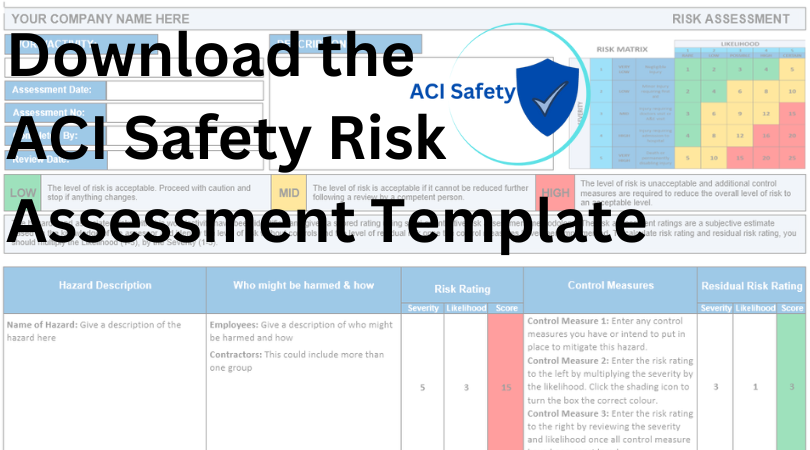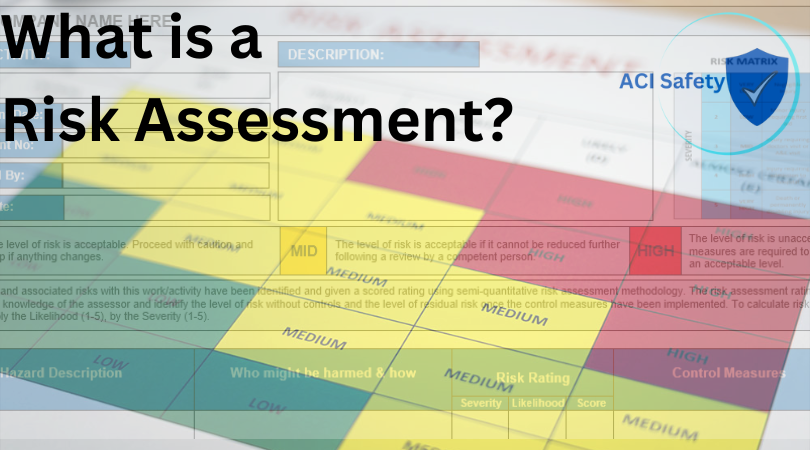Did you know that according the HSE around 1.8 million workers suffered from work-related ill health in 2022/23? This costs UK businesses over £15 billion annually. These facts show how crucial risk assessments are in cutting down accidents and costs. But what is a risk assessment, and why are they vital for businesses?
A risk assessment is a detailed look at possible harm in the workplace, as the Health and Safety Executive (HSE) explains. It helps employers check if they’ve done enough to prevent harm. If not, they know what else to do. The Health and Safety at Work Act 1974 makes it a legal duty for employers to do these assessments. This ensures a safer work environment.
- Risk assessments are a legal must for employers to spot and lessen workplace dangers.
- They’re a thorough check of what could harm people and how to stop or decrease those risks.
- Only those with the right skills and knowledge should do risk assessments.
- These assessments need regular checks and updates, especially with new equipment, substances, or methods.
- Customising risk assessments to fit your business is vital for spotting hazards and managing risks well.
What is a Risk Assessment?
A risk assessment is a careful process used to identify potential dangers in the workplace and evaluate the risks they pose. Companies need to understand what risks are, identify hazards, assess the level of risk, and consider factors that impact the safety of employees and visitors.
Defining Hazards and Risks
Knowing the difference between hazards and risks is key to a good risk assessment.
- Hazard: Anything that could cause harm. This includes things like chemicals, broken equipment, or unsafe working practices.
- Risk: The chance of harm happening and how severe it could be.
In simpler terms:
- Hazards are the sources of possible danger at work.
- Risks are the chances of those hazards causing harm and how bad the harm could be.
Spotting hazards and figuring out their risks is the foundation of a good risk assessment.
Understanding the difference between hazards and risks helps companies take steps to reduce risks, making the workplace safer for everyone.
Why Conduct Risk Assessments?
Conducting a risk assessment is not just a must for employers under the Health and Safety at Work Act 1974 and other laws. It also brings many benefits to your business. As an employer, you must keep your workers and others safe from harm.
Legal Requirements for Employers
You must pick someone skilled to help you with health and safety duties, if you do not have these skills in house, specialist Health and Safety Consultancies like ACI Safety can help. Risk assessments are a large part of these duties, helping you spot dangers, check risks, and take steps to reduce harm. Not doing risk assessments can lead to large fines, legal action, and even criminal charges if there’s an accident.
Benefits of Risk Assessments
Risk assessments have many benefits for your business. They let you look at workplace dangers and risks closely. This means you can:
- Make your workplace safer for your staff, cutting down on accidents and injuries.
- Make sure your business follows health and safety laws.
- Spot problems early, so you can stop them before they start, saving money on accidents.
- Show you care about safety, which can make your business look good and draw in great staff.
- Use your health and safety budget wisely, focusing on the biggest risks.
By conducting risk assessments often and taking action, you make your workplace safer and more productive. You also protect your business from legal and financial trouble from accidents and incidents.
How to Conduct a Risk Assessment
1. Identify Hazards
- Carefully examine your workplace to identify anything that could potentially cause harm. This includes looking for physical hazards like slippery floors, sharp objects, or failing machinery. Also, consider chemical hazards such as dangerous substances, ergonomic hazards like repetitive strain or poor workstation design, psychological hazards such as stress or harassment, and biological hazards like bacteria or viruses.
2. Evaluate Risks
- Assess the likelihood of each identified hazard causing harm and the severity of the potential harm. This involves considering who might be harmed and how, taking into account the different groups of people who might be at risk, such as employees, visitors, or contractors. Determine the frequency of exposure to the hazard and the possible consequences of an incident. Use this information to prioritise the risks that need the most urgent attention.
3. Control Measures
- Decide on the actions that can be taken to reduce or eliminate the identified risks by following the hierarchy of control measures. This hierarchy is a system for controlling risks in order of effectiveness:
- Elimination: Completely remove the hazard from the workplace. This is the most effective control measure.
- Substitution: Replace the hazard with something less dangerous. For example, use a less toxic chemical.
- Engineering Controls: Isolate people from the hazard. This might involve redesigning equipment, installing safety guards, or improving ventilation systems.
- Administrative Controls: Change the way people work. This includes implementing safer procedures, providing training and supervision, and rotating jobs to reduce exposure.
- Personal Protective Equipment (PPE): Use protective gear like gloves, helmets, and goggles. PPE should be the last resort after other measures have been implemented.
4. Record Findings
- Document all identified hazards, the assessed risks associated with them, and the control measures you have put in place to reduce or eliminate those risks. Make sure the records are clear and detailed. This documentation is important for legal compliance and helps ensure that everyone in the workplace is aware of the risks and the measures taken to control them. It can also be useful for future reference and training purposes.

5. Review and Update
- Regularly review and update your risk assessment to ensure it remains effective. This is crucial because new hazards can emerge over time, and existing control measures might need adjustments. Conduct reviews periodically, and also when there are significant changes in the workplace, such as new equipment, new processes, or after an accident or near-miss incident. Keep your records updated to reflect any changes made.
The aim of the risk assessment is to help employers take the right measures to protect their workers and comply with the law. By identifying, evaluating, and controlling risks according to the hierarchy of control measures, companies can create a safer working environment and ensure the well-being of everyone involved.
Who Can Carry Out a Risk Assessment?
As an employer, you have a few options for carrying out a risk assessment. You can do it yourself, choose one or more of your employees, or hire an outside expert. Whoever you choose must be a competent person. A competent person has the right skills, knowledge, and experience to handle health and safety effectively.
If you decide to do it yourself or with your team, consider giving them some training. This ensures they can spot hazards and assess risks in your workplace. Proper training helps them do a thorough and accurate job.
Alternatively, you might hire an external risk assessment expert. This is a good idea if you don’t have the necessary skills in-house or need a fresh perspective on your workplace risks. These experts bring new ideas and a lot of experience, which can help identify risks your team might have missed.
Whether you choose to conduct the risk assessment in-house or hire an external expert, the key is to ensure that the person doing the assessment is competent. They need to be capable of doing the job well.

When Should Risk Assessments Be Performed?
Risk assessments are essential for maintaining a safe workplace and must be conducted regularly. The Management of Health and Safety at Work Regulations 1999 require employers and self-employed individuals to assess the risks to their employees and others who might be affected by their work activities.
Before Starting New Activities: Conduct risk assessments before beginning any new activities to identify and evaluate potential risks.
When Making Changes: Whenever you change work processes, materials, technology, or the work environment, reassess the risks. This ensures your risk assessment remains accurate and effective.
Regular Reviews and Updates
It’s crucial to regularly review and update risk assessments. Here are some specific times when you should do this:
- New Employees: If new workers join your team, especially if they are less experienced or more vulnerable, conduct a new risk assessment to address the specific risks they might face.
- Changes in Regulations: Keep an eye on changes in health and safety laws. If there are updates or new regulations, you may need to review your risk assessments to ensure compliance.
- Significant Changes in Tasks or Environment: Regularly review risk assessments if there are significant changes in work tasks, improvements in processes, or changes in the work environment.
- Incidents and Near Misses: If there are accidents or near misses, reassess the risks to prevent future occurrences and improve safety measures.
- New Health and Safety Information: Stay updated with new health and safety information that might impact your workplace. This could include new research findings, industry standards, or best practices.
- Effectiveness of Control Measures: If the measures you’re using to control risks are not working effectively, perform a new risk assessment to find better solutions.
Workplace Risk Assessment Considerations
It’s vital to keep your employees safe at work. As an employer, you must identify and mitigate various risks, including those from harmful substances, manual handling, and organisational factors. Conducting thorough assessments helps lower risks and makes the workplace safer.
Hazardous Substances Risk Assessment
Exposure to harmful substances can seriously impact your workers’ health. You need to carefully evaluate the dangers associated with using, storing, and disposing of these substances. This includes chemicals, flammable liquids, and other dangerous materials. To keep your workers safe, implement protective measures such as:
- Personal Protective Equipment (PPE): Provide appropriate gear like gloves, masks, and goggles.
- Ventilation Systems: Ensure good airflow to reduce the concentration of harmful substances.
- Safe Handling Procedures: Establish and enforce guidelines for safely handling, storing, and disposing of hazardous materials.
Manual Handling Risk Assessment
Tasks involving lifting, carrying, or moving heavy objects can cause injuries if not performed correctly. Your assessment should examine the risks associated with these tasks, considering factors like the weight and size of items, frequency of handling, and workers’ physical capabilities. To reduce injuries:
- Ergonomic Equipment: Use tools and devices designed to reduce strain.
- Training: Educate workers on proper lifting techniques and safe handling practices.
- Mechanical Aids: Provide equipment such as trolleys and hoists to assist with heavy lifting.
Organisational Risk Factors
The structure and operation of your organisation can also pose risks. Your assessment should consider factors such as work hours, workload, communication, and supervision. Addressing issues like excessive overtime, poor job design, or inadequate training can reduce risks and improve the work environment. Key measures include:
- Work-Life Balance Policies: Promote reasonable work hours and breaks.
- Employee Support: Offer resources for stress management and mental health.
- Clear Procedures: Ensure effective communication and clear guidelines for tasks and responsibilities.
Conclusion
Ensuring the safety of your workplace through regular risk assessments is not only a legal requirement but also a critical step in protecting your employees and your business. A thorough risk assessment process helps you identify potential hazards, evaluate risks, and implement effective control measures. By doing so, you create a safer, more productive work environment and minimise the likelihood of accidents and associated costs.
If you need assistance with your risk assessments or want to ensure they are done to the highest standard, consider reaching out to ACI Safety. We can provide complete risk assessment services specific to your needs, ensuring compliance along with many other benefits. Contact us today at ACI Safety to learn more about how we can help you create a safer workplace.

